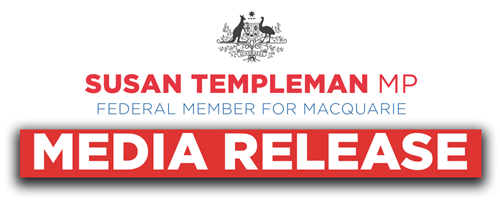
BLUE MOUNTAINS RESIDENTS URGED TO KNOW YOUR BONES
More than 36,000 people living in the Hawkesbury and Blue Mountains have poor bone health, according to Osteoporosis Australia, but many may not realise it until it’s too late.
Member for Macquarie, Susan Templeman joined Olympic Gold Medallist and World Champion Hurdler, Sally Pearson OAM and former Australian Cricket Captain and World Cup Champion, Michael Clarke, to encourage residents to Know Your Bones as part of an awareness campaign for World Osteoporosis Day (20 October).
“According to Osteoporosis Australia, 67 percent of people aged 50 and over in the Hawkesbury and Blue Mountains, have poor bone health,” she said.
“Every year, more than one thousand fractures occur, often from just a minor bump or fall, but many could have been prevented with early diagnosis and treatment.
“Poor bone health can lead to Osteoporosis which makes bones become brittle, leading to a higher risk of breaks than in normal bones resulting in fractures and in some cases immobility.
“Any bone can be affected by osteoporosis, but the most common sites are the hip, spine and wrist. Unfortunately, osteoporosis usually has no symptoms until a fracture occurs,” Ms Templeman said.
“I’ll be getting online and using the Know Your Bones self-assessment tool http://www.knowyourbones.org.au/, developed by Osteoporosis Australia and the Garvan Institute of Medical Research, and I urge everyone aged 50 and over to do the same,” Ms Templeman said.
Olympic Gold Medallist, Sally Pearson OAM said it is very important that Australians are aware of their bone health.
“With my own personal history of bone fractures, I understand how important it is to look after your bones.
“I’d encourage more Australians to use the Know Your Bones online self- assessment tool.
“I also encourage anyone with concerns about their results to talk to their GP.” Ms Pearson said.
Osteoporosis currently affects more than 5.5 million Australians over 50. While osteoporosis disproportionately affects women, men also need to check their bone health with 25 percent of cases occurring in men.
“As with many chronic conditions, prevention is better than cure. Exercise is also recognised as one of the most effective lifestyle strategies to help make bones as strong as possible, reducing the risk of fractures later in life.” Ms Pearson said.
Mr Clarke added, “A calcium rich diet with foods such as dairy, certain vegetables, fruit and nuts also helps to maintain your bone health”.
“Looking after your bones is important for young people as well as men and women to reduce the risk of osteoporosis which can lead to broken bones.” Mr Clarke said.
Osteoporosis Australia Medical Director, Professor Peter Ebeling AO said “A broken bone is usually a sign that we need to take action to prevent more bone loss, as each fracture significantly raises the risk of a further fracture,” he said.
Key Facts
- In Australia a bone is broken every 3.3 minutes due to poor bone health and there will be over 165,000 fractures this year alone
- Two-thirds of Australians over 50 have poor bone health
- In 2017 the brittle bones of Australians aged 50+ cost the economy $3.1 billion


